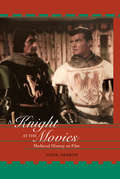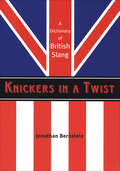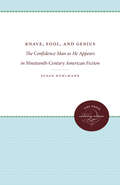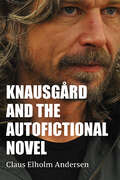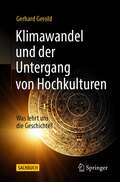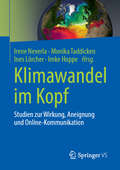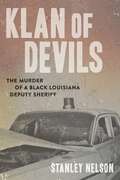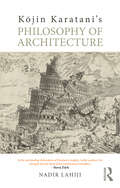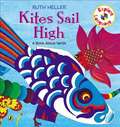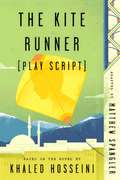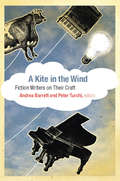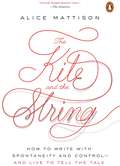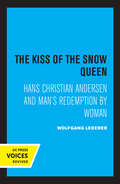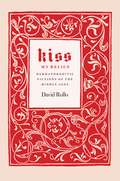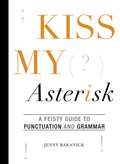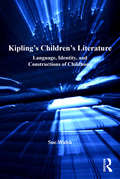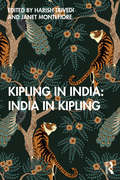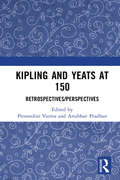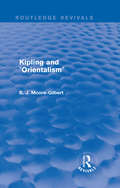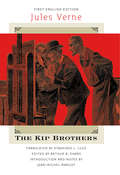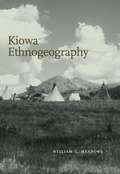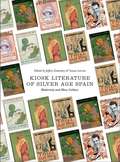- Table View
- List View
A Knight at the Movies: Medieval History on Film
by John AberthImagining the Middle Ages is an unprecedented examination of the historical content of films depicting the medieval period from the 11th to the 15th centuries. Historians increasingly feel the need to weigh in on popular depictions of the past, since so much of the public's knowledge of history comes from popular mediums. Aberth dissects how each film interpreted the period, offering estimations of the historical accuracy of the works and demonstrating how they project their own contemporary era's obsessions and fears onto the past.
Knickers in a Twist: A Dictionary of British Slang
by Jonathan BernsteinDon&’t play the silly bugger in front of your mates! Take a deep dive into British language and culture with this &“hilarious and entertaining&” reference (Chicago Tribune). Brits and Americans dress the same, eat at the same chain restaurants, and pass music back and forth across the Atlantic, and our national leaders are practically conjoined twins. But the second the Brits open their mouths, all bets are off. So don&’t dream of visiting the United Kingdom, dating a Brit, or truly understanding what Jude Law is saying without this handy, hilarious, and informative guide to Britspeak. With the cheekiness of Austin Powers and the tidbit quotient of Schott&’s Miscellany, screenwriter Jonathan Bernstein&’s collection of Cockney rhyming slang, insults culled from British television shows of yore, and regional and &“high British&” favorites provides hours of educational, enlightening, even life-saving hilarity. And if it doesn&’t accomplish that, at least you&’ll be aware that when a British citizen describes you as a &“wally,&” a &“herbert,&” a &“spanner,&” or a &“bampot,&” he&’s not showering you with compliments. Knickers in a Twist is as indispensable as a London city guide, as spot-on funny as an episode of The Office, and as edifying as Born to Kvetch and Eats, Shoots and Leaves. &“Indispensable.&” —Vanity Fair &“Will probably do more for revolutionizing the way you and your nearest and dearest address one another than any other book out this year . . . Often bring[s] an overt chuckle.&” —Edge New York
Knave, Fool, and Genius: The Confidence Man as He Appears in Nineteenth-Century American Fiction
by Susan KuhlmannThe confidence man held a fascination for Melville, Hawthorne, Howells, Johnson J. Hooper, Bret Harte, and Mark Twain. In this study the writers are grouped in such a way as to emphasize certain large-scale cultural patterns of nineteenth-century America. Primary attention is given to the con man character himself and the ways in which he reflects the unique qualities and perceptions of a given writer.Originally published in 1973.A UNC Press Enduring Edition -- UNC Press Enduring Editions use the latest in digital technology to make available again books from our distinguished backlist that were previously out of print. These editions are published unaltered from the original, and are presented in affordable paperback formats, bringing readers both historical and cultural value.
Knausgård and the Autofictional Novel
by Claus Elholm AndersenNorwegian author Karl Ove Knausgård’s six-volume, 3600-page autobiographical novel, My Struggle, has been widely hailed for its heroic exploration of selfhood, compulsive readability, and restless experimentation with form and genre. Knausgård and the Autofictional Novel explains why. Across four chapters, Claus Elholm Andersen shows how Knausgård confronts, challenges, and rejects the symbiotic relationship between novels and fiction, particularly via a technique of "auto-fictionalization." The fifth chapter then explores the further breakdown of this relationship in autofiction by Sheila Heti, Rachel Cusk, and Ben Lerner, taking readers to what Lerner called "the very edge of fiction."
Klimawandel und der Untergang von Hochkulturen: Was lehrt uns die Geschichte?
by Gerhard GeroldGlobale Klimaveränderung und Klimakollaps sind in Medien und Gesellschaft ein inzwischen viel beachtetes Thema geworden. Der Zusammenbruch alter Hochkulturen wird dabei in Verbindung mit plötzlichen Klimaveränderungen gebracht. Anhand neuester Forschungsergebnisse gibt das Buch Antworten auf die Rolle von Klimaveränderung für den Kollaps alter Hochkulturen zu unterschiedlichen Zeiten und Kontinenten – von Mesopotamien bis nach Grönland. Dabei erfolgt eine Zusammenschau von archäologischen und paläoklimatischen Erkenntnissen unter Berücksichtigung der damaligen ökonomischen, politischen und religiös-kulturellen Verhältnisse. Der Geograph Gerhard Gerold legt mit diesem Buch eine detaillierte Analyse der schon in historischer Zeit bestehenden komplexen Vernetzung kulturgeschichtlicher und umweltökologischer Bedingungen vor, die für unsere heutige globalisierte Welt eine große Aktualität besitzen. Das Buch bietet zahlreiche Beispiele für den Vergleich damaliger und heutiger Umweltkrisen. Der Autor: Gerhard Gerold gehört als Mitglied der Nationalen Akademie der Wissenschaften Leopoldina zu den Wissenschaftlern, die sich schon seit den 80er Jahren mit Themen der Umweltzerstörung in den Tropen beschäftigt haben. Der Zusammenbruch früher Hochkulturen in Verbindung mit regionalen Klimaänderungen faszinierten ihn im Rahmen seiner umfangreichen geoökologischen Forschungsarbeiten.
Klimawandel im Kopf: Studien zur Wirkung, Aneignung und Online-Kommunikation
by Irene Neverla Monika Taddicken Ines Lörcher Imke HoppeKlimawandel ist ein Meta-Thema - seit Jahrzehnten auf der Agenda der Medien, global diskutiert, mit vielen Anschlusspunkten in politische, wirtschaftliche, kulturelle Fragen und Alltagsbelange. Was aber findet sich in den Köpfen der Menschen zum Thema Klimawandel? Welche Kommunikationskanäle, welche journalistischen und welche Online-Angebote waren dafür wichtig, und wie hängen Wissen, Einstellungen und Verhaltensbereitschaften damit zusammen? Die mit verschiedenen Methoden erarbeiteten Ergebnisse in diesem Buch zeigen, wie ,eigensinnig' bzw. kreativ sich Menschen das Thema Klimawandel aneignen, wie vielfach vernetzt und ,rhizomartig' die klimabezogene Kommunikation verläuft.
Klang – Ton – Wort: akustische Dimensionen im Schaffen Marcel Beyers
by Sven Lüder Alice StaškováMarcel Beyer hat mit seinem vielfach ausgezeichneten Schaffen auf einzigartige Weise Grenzbereiche zwischen Literatur, Musik und Kulturtheorie erkundet. Sein Œuvre, das außer Romanen, Gedicht- und Essaybänden auch fünf Libretti umfasst, zeichnet sich durch eine spezifische Aufmerksamkeit für das Akustische aus, wobei Fragen der Darstellung, der Systematisierung und der Performanz stets mitbedacht werden. Auf vielfältige, bislang kaum angemessen ergründete Weise verschränken sich in seinem Schaffen Erfahrungen als Mitwirkender (Sprecher), als Autor von musikbezogenen Essays (v. a. Rezensionen) und als Co-Autor zumal im Musiktheater. Der Band, der auf ein 2019 in Jena veranstaltetes Symposium zurückgeht, enthält Beiträge, die in umfassend interdisziplinärer Weise die Dimensionen des Akustischen in Beyers Werken sowie Ausfaltungen des Dialogs zwischen Musik und Literatur, besonders auch in der Praxis des zeitgenössischen Musiktheaters, untersuchen.
Klan of Devils: The Murder of a Black Louisiana Deputy Sheriff
by Stanley NelsonIn the summer of 1965, several Ku Klux Klan members riding in a pickup truck shot two Black deputies on patrol in Washington Parish, Louisiana. Deputy Oneal Moore, the driver of the patrol car and father of four daughters, died instantly. His partner, Creed Rogers, survived and radioed in a description of the vehicle. Less than an hour later, police in Mississippi spotted the truck and arrested its driver, a decorated World War II veteran named Ernest Ray McElveen. They returned McElveen to Washington Parish, where he spent eleven days in jail before authorities released him. Afterward, the FBI sent its top inspector to Bogalusa, Louisiana, to participate in the murder inquiry—the only civil rights–era FBI investigation into the killing of a Black law enforcement officer by the KKK. Despite that assistance, lack of evidence and witnesses unwilling to come forward forced Louisiana prosecutors eventually to drop all charges against McElveen. The FBI continued its investigation but could not gather enough evidence to file charges, leaving the murder of Oneal Moore unsolved. Klan of Devils: The Murder of a Black Louisiana Deputy Sheriff is Stanley Nelson’s investigation of this case, which the FBI probed from 1965 to 2016. Nelson describes the Klan’s growth, and the emergence of Black activism in Bogalusa and Washington Parish, against the backdrop of political and social change in the 1950s and early 1960s. With the assistance of two retired FBI agents who worked the case, Nelson also explores the lives of the primary suspects, all of whom are now dead, and points to the Klansmen most likely responsible for the senseless and horrific attack.
Kōjin Karatani’s Philosophy of Architecture
by Nadir LahijiIn this book, Nadir Lahiji introduces Kōjin Karatani’s theoretical-philosophical project and demonstrates its affinity with Kant’s critical philosophy founded on ‘architectonic reason’. From the ancient Greeks we have inherited a definition of the word ‘philosophy’ as Sophia—wisdom. But in his book Architecture as Metaphor Kōjin Karatani introduces a different definition of philosophy. Here, Karatani critically defines philosophy not in association with Sophia but in relation to foundation as the Will to Architecture. In this novel definition resides the notion that in Western thought a crisis persistently reveals itself with every attempt to build a system of knowledge on solid ground. This book reveals the implications of this extraordinary exposition. This is the first book to uncover Kōjin Karatani’s highly significant ideas on architecture for both philosophical and architectural audiences.
Kites Sail High: A Book About Verbs (Explore!)
by Ruth HellerThis is a whole sentence in one single word, and of course this can only be done by a verb.
The Kite Runner (Play Script): Based on the novel by Khaled Hosseini
by Matthew SpanglerThe script for the stage production of Khaled Hosseini's first and internationally bestselling novel, The Kite Runner, as adapted by playwright Matthew Spangler. The unforgettable, heartbreaking story of the unlikely friendship between a wealthy boy and the son of his father's servant, The Kite Runner is a beautifully crafted novel set in a country that is in the process of being destroyed. Now adapted for the stage, the story is about the power of reading, the price of betrayal, and the possibility of redemption, and is an exploration of the influence of fathers over sons--their love, their sacrifices, their lies.A sweeping saga of family, love, and friendship told against the devastating backdrop of the history of Afghanistan over the last thirty years, The Kite Runner is an unusual and powerful story that has become a beloved, one-of-a-kind classic.This adaptation was first performed at Wyndham's Theatre, London, in December 2016.
A Kite in the Wind
by Andrea Barrett Peter TurchiA Kite in the Wind is an anthology of essays by 20 veteran writers and master teachers. While the contributors offer specific, practical advice on such fundamental aspects of craft as characterization, character names, the first person point of view, and unreliable narrators, they also give extended, thoughtful consideration to more sophisticated topics, including "imminence," or the power of a sense of beginning; creating and maintaining tension; "lushness"; and the deliberate manipulation of information to create particular effects.The essays in A Kite in the Wind begin as personal investigations - attempts to understand why a decision in a particular story or novel seemed unsuccessful; to define a quality or problem that seemed either unrecognized or unsatisfactorily defined; to understand what, despite years of experience as a fiction writer, resisted comprehension; and to pursue haunting, even unanswerable questions.Unlike a how-to book, the anthology is less an instruction manual than it is an intimate visit with twenty very different writers as they explore topics that excite, intrigue, and even puzzle them. Each discussion uses specific examples and illustrations, including both canonical stories and novels and writing less frequently discussed, from the 19th, 20th, and 21st centuries, by both American and international authors.The contributors share their hard-earned insights for beginning and advanced writers with humility, wit, and compassion. The first section of the book focuses on narration, with particular attention paid to various kinds of narrators; the second, on strategic creation and presentation of character; the third, on some of the roles of the visual, beginning with establishing setting; and the fourth, on structural and organizational issues, from movement through time to the manipulation of information to create mystery and suspense.
The Kite and the String: How to Write with Spontaneity and Control--and Live to Tell the Tale
by Alice MattisonA targeted and insightful guide to the stages of writing fiction and memoir without falling into common traps, while wisely navigating the writing life, from an award-winning author and longtime teacherWriting well does not result from following rules and instructions, but from a blend of spontaneity, judgment, and a wise attitude toward the work--neither despairing nor defensive, but clear-eyed, courageous, and discerning. Writers must learn to tolerate the early stages, the dreamlike and irrational states of mind, and then to move from jottings and ideas to a messy first draft, and onward into the work of revision. Understanding these stages is key.The Kite and the String urges writers to let playfulness and spontaneity breathe life into the work--letting the kite move with the winds of feeling--while still holding on to the string that will keep it from flying away. Alice Mattison attends also to the difficulties of protecting writing time, preserving solitude, finding trusted readers, and setting the right goals for publication. The only writing guide that takes up both the stages of creative work and developing effective attitudes while progressing through them, plus strategies for learning more about the craft, The Kite and the String responds to a pressing need for writing guidance at all levels.
The Kiss of the Snow Queen: Hans Christian Andersen and Man's Redemption by Woman
by Wolfgang LedererThis title is part of UC Press's Voices Revived program, which commemorates University of California Press’s mission to seek out and cultivate the brightest minds and give them voice, reach, and impact. Drawing on a backlist dating to 1893, Voices Revived makes high-quality, peer-reviewed scholarship accessible once again using print-on-demand technology. This title was originally published in 1986.
Kiss My Relics: Hermaphroditic Fictions Of The Middle Ages
by David RolloConservative thinkers of the early Middle Ages conceived of sensual gratification as a demonic snare contrived to debase the higher faculties of humanity, and they identified pagan writing as one of the primary conduits of decadence. Two aspects of the pagan legacy were treated with particular distrust: fiction, conceived as a devious contrivance that falsified God's order; and rhetorical opulence, viewed as a vain extravagance. Writing that offered these dangerous allurements came to be known as "hermaphroditic" and, by the later Middle Ages, to be equated with homosexuality. At the margins of these developments, however, some authors began to validate fiction as a medium for truth and a source of legitimate enjoyment, while others began to explore and defend the pleasures of opulent rhetoric. Here David Rollo examines two such texts--Alain de Lille's De planctu Naturae and Guillaume de Lorris and Jean de Meun's Roman de la Rose--arguing that their authors, in acknowledging the liberating potential of their irregular written orientations, brought about a nuanced reappraisal of homosexuality. Rollo concludes with a consideration of the influence of the latter on Chaucer's Pardoner's Prologue and Tale.
Kiss My Asterisk: A Feisty Guide to Punctuation and Grammar
by Jenny BaranickGrammar has finally let its hair down! Unlike uptight grammar books that overwhelm us with every single grammar rule, Kiss My Asterisk is like a bikini: it’s fun, flirty, and covers only the most important bits. Its lessons, which are 100 percent free of complicated grammar jargon, have been carefully selected to include today’s most common, noticeable errors-the ones that confuse our readers or make them wonder if we are, in fact, smarter than a fifth grader. What is the proper use of an apostrophe? When should an ellipsis be used instead of an em dash? Why do we capitalize President Obama but not "the president”? And why is that question mark placed outside of the end quote?Author Jenny Baranick is an English professor whose students can’t believe she’s actually that into grammar. Upon experiencing the joys of grammar at an early age, raising grammar awareness became Jenny’s raison d’être. By spreading her remarkably user-friendly and hilarious approach to grammar, she hopes everyone will experience the satisfaction of a properly placed comma, a precisely used semicolon, and a correctly deployed en dash.Kiss My Asterisk shows grammar as it’s never been seen before: uncomplicated, laugh-out-loud funny, and, dare we say, a little risqué.
The Kiss
by Kathryn HarrisonHere comes a true story about A Woman Who Slept with Her Father--prime fodder for the TV talk show feeding frenzy. Certainly it would be easy to lump Kathryn Harrison's new memoir, The Kiss into this same category of titillating topics, but that would be a mistake. There is nothing remotely titillating about Harrison's book; instead, it reads like a slow descent into hell--one that compels and repels in almost equal measure at times. Harrison, who did not really meet her father until she was 20, takes the reader on a difficult journey into her loveless childhood, her bouts with anorexia and bulimia, and, eventually, the incestuous 4-year affair with her father. Her prose is deceptively simple; her choice of present tense to describe events that occurred many years ago forces an immediacy--almost a complicity--upon the reader that heightens both revulsion and compassion. The Kiss is not for everybody. Some readers will be outraged by its subject matter; others will find it just too painful to read. But for those who make it through, this harrowing tale promises the reward of a life reclaimed and a tragedy transcended.
Kipper's A to Z: An Alphabet Adventure
by Mick InkpenKirkus Reviews Canine Kipper squires his piglet friend, Arnold, from "Aa is for ant" to "Zz is for Zebra" in a big, playful, alphabet story that is just the ticket for turning pre-readers into new readers. Inkpen adds a bit extra to most of the literary encounters: "Cc" is not just for caterpillar, but Crawly caterpillar; "Nn is for No, not now" (said to the zebra); and "Xx" for Xugglybug, an "interesting insect" picked up at "Ii." The best moment is when the audience is invited to help Kipper out when his mind goes blank at "Kk." Young children will also painlessly discover an array of additional concepts as, for instance, Kipper and Arnold go up and down a hill, discover that an elephant is too big to fit into Arnold's collecting box, or learn that the first letter of "gnat" is silent. Acres of white space surround the large-type text and simply drawn figures without overwhelming them, making this equally suitable for sharing with one child or a group. Just about the cutest puppy in a favorite series achieves a stellar new success. (Picture book. 3-5) A truly fun and funny alphabet book!
Kipling's Children's Literature: Language, Identity, and Constructions of Childhood (Studies in Childhood, 1700 to the Present)
by Sue WalshDespite Kipling's popularity as an author and his standing as a politically controversial figure, much of his work has remained relatively unexamined due to its characterization as 'children's literature'. Sue Walsh challenges the apparently clear division between 'children's' and 'adult' literature, and poses important questions about how these strict categories have influenced critical work on Kipling and on literature in general. For example, why are some of Kipling's books viewed as children's literature, and what critical assumptions does this label produce? Why is it that Kim is viewed by critics as transcending attempts at categorization? Using Kipling as a case study, Walsh discusses texts such as Kim, The Jungle Books, the Just-So Stories, Puck of Pook's Hill, and Rewards and Fairies, re-evaluating earlier critical approaches and offering fresh readings of these relatively neglected works. In the process, she suggests new directions for postcolonial and childhood studies and interrogates the way biographical criticism on children's literature in particular has tended to supersede and obstruct other kinds of readings.
Kipling in India: India in Kipling
by Harish Trivedi and Janet MontefioreThis book explores and re-evaluates Kipling’s connection with India, its people, culture, languages, and locales through his experiences and his writings. Kipling’s works attracted interest among a large section of the British public, stimulating curiosity in their far-off Indian Empire, and made many canonize him as an emblem of the ‘Raj’. This volume highlights the astonishing social and thematic range of his Indian writings as represented in The Jungle Books; Kim; his early verse; his Simla-based tales of Anglo-Indian intrigues and love affairs; his stories of the common Indian people; and his journalism. It brings together different theoretical and contextual readings of Kipling to examine how his experience of India influenced his creative work and conversely how his imperial loyalties conditioned his creative engagement with India. The 18 chapters here engage with the complexities and contradictions in his writings and analyse the historical and political contexts in which he wrote them, and the contexts in which we read him now. With well-known contributors from different parts of the world – including India, the UK, the USA, Canada, France, Japan, and New Zealand – this book will be of great interest not only to those interested in Kipling’s life and works but also to researchers and scholars of nineteenth-century literature, comparative studies, postcolonial and subaltern studies, colonial history, and cultural studies.
Kipling and Yeats at 150: Retrospectives/Perspectives
by Promodini Varma Anubhav PradhanThis book evaluates the parallels, divergences, and convergences in the literary legacies of Rudyard Kipling and William Butler Yeats. Coming 150 years after their birth, the volume sheds light on the conversational undercurrents that pull together the often diametrically polar worldviews of these two seminal figures of the English literary canon. Contextualizing their texts to the larger milieu that Kipling and Yeats lived in and contributed to, the book investigates a range of aesthetic and perceptual similarities – from cultures of violence to notions of masculinity, from creative debts to Shakespeare to responses to British imperialism and industrial modernity – to establish the perceptible consonance of their works. Kipling and Yeats are known to have never corresponded, but the chapters collected here show evidence of the influence that their acute awareness of each other’s work and thought may have had. Offering fresh perspectives which make Kipling’s and Yeats’s diverse texts, contexts, and legacies contemporarily relevant, this volume will be of great interest to scholars and researchers of literature, critical theory, postcolonial studies, cultural studies, and comparative literature.
Kipling and Orientalism (Routledge Revivals)
by B. J. Moore-GilbertFirst published in 1986, this book sets Kipling firmly in the historical context not only of contemporary India but of prior Anglo-Indian writers about India. Despite his enthusiastic reception in England as ‘revealer of the East’, in India he seems to have been regarded as just one more Anglo-Indian writer. The author demonstrates the traditionalism of Kipling’s use of the themes of Anglo-Indian fiction – themes such as the ‘White Man’s grave’, domestic instability, frustration and loneliness. In particular, Kipling is shown to be writing in a strongly conservative idiom, concentrating on the role of the British hierarchy as the determining factor in a response to India, on British insecurity and fears of a repeat of the 1857 mutiny, and regarding Indian institutions only in so far as they represented a threat to British rule. Conservative critiques of liberalism are also discussed.
The Kip Brothers (Early Classics of Science Fiction)
by Jules Verne Stanford L. Luce Jean-Michel Margot Arthur B. EvansCastaways on a barren island in the South Seas, Karl and Pieter Kip are rescued by the brig James Cook. After helping to quell an onboard mutiny, however, they suddenly find themselves accused and convicted of the captain's murder. In this story, one of his last Voyages Extraordinaires, Verne interweaves an exciting exploration of the South Pacific with a tale of judicial error reminiscent of the infamous Dreyfus Affair. This Wesleyan edition brings together the first English translation with one of the first detailed critical analyses of the novel, and features all the illustrations from the original 1902 publication.
Kiowa Ethnogeography
by Meadows William C.Examining the place names, geographical knowledge, and cultural associations of the Kiowa from the earliest recorded sources to the present, Kiowa Ethnogeography is the most in-depth study of its kind in the realm of Plains Indian tribal analysis. Linking geography to political and social changes, William Meadows applies a chronological approach that demonstrates a cultural evolution within the Kiowa community. Preserved in both linguistic and cartographic forms, the concepts of place, homeland, intertribal sharing of land, religious practice, and other aspects of Kiowa life are clarified in detail. Native religious relationships to land (termed "geosacred" by the author) are carefully documented as well. Meadows also provides analysis of the only known extant Kiowa map of Black Goose, its unique pictographic place labels, and its relationship to reservation-era land policies. Additional coverage of rivers, lakes, and military forts makes this a remarkably comprehensive and illuminating guide.
Kiosk Literature of Silver Age Spain: Modernity And Mass Culture
by Jeffrey Zamostny Susan LarsonThe so-called “Silver Age” of Spain ran from 1898 to the rise of Franco in 1939 and was characterized by intense urbanization, widespread class struggle and mobility, and a boom in mass culture. This book offers a close look at one manifestation of that mass culture: weekly collections of short, often pocket-sized books sold in urban kiosks at low prices. These series published a wide range of literature in a variety of genres and formats, but their role as disseminators of erotic and anarchist fiction led them to be censored by the Franco dictatorship. This book offers the most detailed scholarly analysis of kiosk literature to date, examining the kiosk phenomenon through the lens of contemporary interdisciplinary theories of urban space, visuality, celebrity, gender and sexuality, and the digital humanities.
